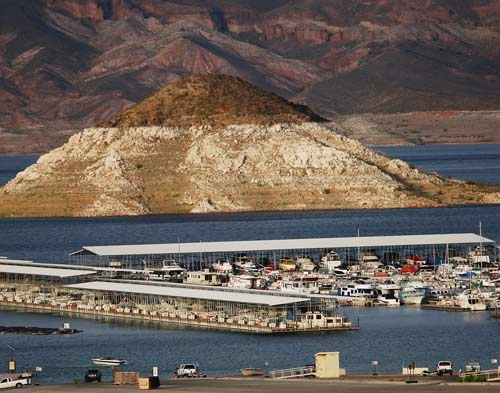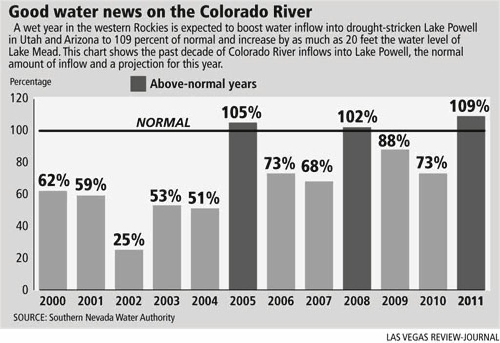Wet year to boost level of Lake Mead
Lake Mead is expected to rise almost 20 feet over the next 10 months, thanks to the wettest year in more than a decade on the drought-ravaged Colorado River.
The U.S. Bureau of Reclamation has announced plans to release extra water from Lake Powell between now and September under federal guidelines that direct the "equalization" of the nation's two largest man-made reservoirs.
Lake Powell is required to send a minimum of 8.23 million acre-feet of water downstream to Mead each year. On Friday, bureau officials set this year's release at 11.56 million acre-feet, more than enough to stave off an unprecedented shortage declaration that would require Nevada and Arizona to cut their river use.
Pat Mulroy, general manager of the Southern Nevada Water Authority, said it's nice to have some good news for a change.
"I'm delighted, absolutely delighted. We're not going to lose any ground this year," she said.
LAKE MEAD RUNNING LOW
Lake Mead sank to a record low in November before rebounding over the past four months. The surface of the lake now sits at 1,096 feet above sea level, 115 feet below where it was when the drought began 11 years ago.
Las Vegas Valley draws about 90 percent of its drinking water supply from the Colorado River by way of Lake Mead.
One acre-foot of water is enough to supply two average Las Vegas Valley homes for one year.
The extra 3.3 million acre-feet Lake Mead soon will receive is roughly 14 times the amount of Colorado River water used valleywide last year.
A drop to elevation 1,075 at Lake Mead would trigger a 13,000 acre-foot reduction in Nevada's annual share of river water and far deeper cuts for Arizona.
And such a drop would prompt a vote by the Southern Nevada Water Authority board on whether to build a controversial pipeline to tap groundwater across eastern Nevada.
This year's extra release from Lake Powell could delay both actions for several years.
The news is also good for the Lake Mead National Recreation Area, where marina operators and park officials have spent much of the last decade chasing the receding shoreline.
"We are very happy that we're getting extra water this year," said Andrew Muñoz, park service spokesman at Lake Mead. "The rising water will change our operation, and it will change it for the good."
The lake level generally falls during the summer, as more water is released through Hoover Dam to meet the peak demands of farms and cities downstream. Forecasters expect the extra water from Lake Powell to result in a gradual rise at Mead that could last through February 2012.
TIMING GOOD FOR RECREATION
The timing couldn't be better, Muñoz said, because this will mark the first summer in several years with no work scheduled at any of Lake Mead's boat launch ramps.
"It will be a very good boating season this year," he said.
The rising water will prompt some minor work -- mostly grading beaches and moving portable toilets -- but it's preferable to the expensive upgrades and facility closures of the past several years.
Muñoz said the lake is expected to swell enough to require a few marinas to move their operations in toward the shore. Such moves are cheaper and easier, he said, because they don't require the extension of utility lines and other infrastructure.
Almost all of the Colorado River's flow starts as snow that collects in the mountains of Colorado, Utah and Wyoming from November to late May.
Lake Powell swells with that water in early summer, rising sometimes by a foot or more a day as the snow starts to melt and flow downstream.
In 2007, state and federal officials agreed on the framework that now governs the coordinated rise and fall of lakes Mead and Powell. The rules are designed to protect minimum water levels in the two reservoirs through the year 2026.
The Colorado River has flowed at 69 percent of normal during the past 11 years of record drought in the region.
This year, forecasters expect the river's flow to reach its highest level in 12 years.
Just don't expect anyone to declare an end to the drought yet.
"Whether this is the beginning of the end of the drought or a high-flow year in a longer drought cycle we won't know," Mulroy said. "For right now, I'm delighted."
Contact reporter Henry Brean at hbrean@reviewjournal.com or 702-383-0350.





























